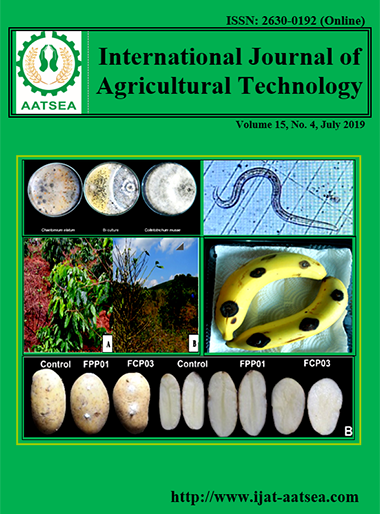Identification of Fusarium spp. causing dry rot of seed potato tubers in northern, Thailand
Main Article Content
Abstract
Fusarium dry rot (FDR) is an important potato disease causing post-harvest tuber rot and seed piece decay worldwide. The causative agent of potato dry rot was identified in northern Thailand, based on the characterization and pathogenicity of the isolated pathogen. Infected potato tuber samples from different areas in northern Thailand showed potato dry rot symptom. Fusarium species were identified, based on morphology and the internal transcribed spacer (ITS) region of the nuclear ribosomal DNA (rDNA) and pathogenicity. The effect of wounding on infection by Fusarium species in potato tubers was studied, four injury levels were evaluated to determine the influence of wound severity on infection by each Fusarium species. F. graminearum and F. solani were isolated from diseased potato tubers in Chiang Mai and Tak Province in Thailand, respectively. F. graminearum was the most aggressive and exhibited typical external dry rot lesions expressed as brown to black flecks on the tuber surface. This is the first report to evaluate the importance of F. graminearum as potato pathogen in Thailand.
Article Details

This work is licensed under a Creative Commons Attribution-NonCommercial-NoDerivatives 4.0 International License.
References
Aktaruzzaman, M. D., Xu, S. J., Kim, J. Y., Woo, J. H., Hahm, Y. and Kim, B. S. (2014). First Report of potato stem-end rot caused by Fusarium oxysporum in Korea. Mycobiology, 42:206-209.
Alison, S., Rivera, V. V. and Secor, G. A. (2005). First report of Fusarium graminearum causing dry rot of potato in North Dakota. Plant Pathology Journal, 89:105.
Al-Mughrabi, K. (2010). Biological control of Fusarium dry rot and other potato tuber diseases using Pseudomonas fluorescens and Enterobacter cloacae. Biological control, 53:280-284.
Aydın, M. H., Pala, F. and Kaplan, C. (2016). Potato tuber sprout rot caused by Fusarium sambucinum in Turkey. Scientific Papers. Series A. Agronomy, 54:189-193.
Booth, C. (1971). The genus Fusarium. In: Fusarium solani var. coeruleum. Kew (UK), Commonwealth Mycological Institute, pp:51-54.
Boutheina, M. T., Hayfa, J. K. and Mejda, D. R. (2015). Interactions between four Fusarium species in potato tubers and consequences for fungal development and susceptibility assessment of five potato cultivars under different storage temperature. Journal of Plant Pathology and Microbiology, 6:1-12.
Choiseul, J., Allen, L. and Carnegie, S. (2007). Fungi causing dry tuber rots of seed potatoes in storage in Scotland. American Journal of Potato Research, 49:241-253.
Du, M., Ren, X., Sun, Q., Wang, Y. and Zhang, R. (2012). Characterization of Fusarium spp. causing potato dry rot in China and susceptibility evaluation of chinese potato germplasm to the pathogen. Potato Research, 55:175-184.
Estrada, R., Gudmestad, N. C., Rivera, V. V. and Secor, G. A. (2010). Fusarium graminearum as a dry rot pathogen of potato in the USA: prevalence, comparison of host isolate aggressiveness and factors affecting aetiology. Plant Pathology Journal, 59:1114-1120.
Gachango, E., Hanson, L. E., Rojas, A., Hao, J. J. and Kirk, W. W. (2012). Fusarium spp. causing dry rot of seed potato tubers in Michigan and their sensitivity to fungicides. Plant Disease, 96:1767-1774.
Gardes, M. and Bruns, T. D. (1993). ITS primers with enhanced specificity for Basidiomycetes – Application to the identification of mycorrhizae and rusts. Molecular Ecology, 2:113-118.
Gashgari, R. M. and Gherbawy, Y. A. (2013). Pathogenicity of some Fusarium species asscociated with superficial blemishes of potato tubers. Polish Journal of Microbiology, 62:59-66.
Hooker, W. J. (2001). Compendium of Potato Diseases American Phytopathological Society, St. Paul, MN. Plant Pathology, 51:518-521.
Islam, R. and Datta, B. (2017). Characterization of Fusarium solani KUSF204 as a potential metal tolerant plant growth promoting fungus. International Journal of Pharma and Bio Sciences, 7:151-161.
Mirhendi, H., Ghiasian, A., Vismer, H. F., Asgary, M. R., Jalalizand, N., Arendrup, M. C. and Makimura, K. (2010). Preliminary identification and typing of pathogenic and toxigenic Fusarium species using restriction digestion of ITS1-5.8S rDNA-ITS2 region. Iranian Journal of Public Health, 39:35-44.
Muthoni, J. and Nyamongo, D. O. (2009). A review of constraints to ware Irish potatoes production in Kenya. Journal of Horticulture and Forestry, 1:098-102.
Padvi, S. A., Khaire, P. B., Bhagat, V. H. and Hingole, D. G. (2018). Studies on cultural, morphological variability in isolates Fusarium solani, incitant of dry root-rot of sweet orange. International Journal of Current Microbiology and Applied Sciences, 7:3671-3676.
Singha, I. M., Kakoty, Y., Unni, B. G., Dasd, J. and Kalitae, M. C. (2016). Identification and characterization of Fusarium sp. using ITS and RAPD causing Fusarium wilt of tomato isolated from Assam, North East India. Genetic Engineering and Biotechnology Journal, 14:99-105.
Stefańczyk, E., Sobkowiak, S., Brylińska, M. and Śliwka, J. (2016). Diversity of Fusarium spp. associated with dry rot of potato tubers in Poland. European Journal of Plant Pathology, 145:871-884.
Steven, D. H. (2005). Morphogenesis in germinating Fusarium graminearum macroconidia. Mycologia, 97:880-887.


